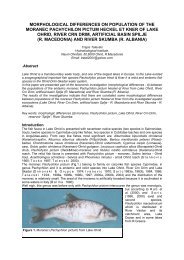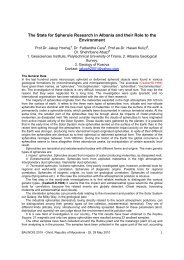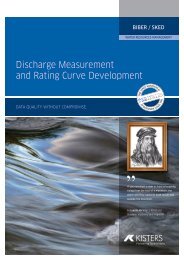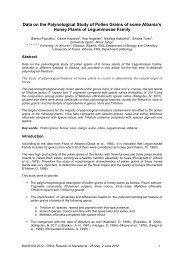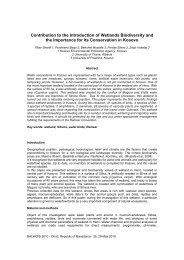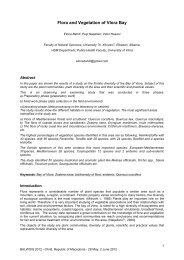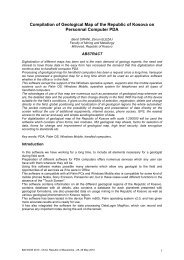dams with impervious membrane of asphalt concrete - Balwois
dams with impervious membrane of asphalt concrete - Balwois
dams with impervious membrane of asphalt concrete - Balwois
You also want an ePaper? Increase the reach of your titles
YUMPU automatically turns print PDFs into web optimized ePapers that Google loves.
The body <strong>of</strong> a dam, as shown in the figure, consists <strong>of</strong> quarry run limestone, placed in layers and<br />
compacted by vibrating rollers. It is divided into two zones, the grading and permeability <strong>of</strong> which<br />
increases from upstream to downstream.<br />
As for the watertight <strong>membrane</strong> on the upstream face, it extends to the walls and the bottom <strong>of</strong> the whole<br />
reservoir. The <strong>membrane</strong> consists <strong>of</strong> a single layer (I) <strong>of</strong> dense-graded bituminous mix, 8 cm thick, which<br />
is spread over a binding layer (BN) <strong>of</strong> semi-open graded bituminous mix, 10 cm thick. The binding layer<br />
rests on a drainage layer (DR) <strong>of</strong> crushed stone. The system <strong>of</strong> pipes and drainage galleries makes it<br />
possible to check and measure any seepage throughout the <strong>membrane</strong>.<br />
The downstream face <strong>of</strong> the dam is lined <strong>with</strong> a layer <strong>of</strong> top soil, placed inside appropriate prefabricated<br />
works.<br />
As we can see from this example, opposite from the two types <strong>of</strong> the design that we mentioned earlier,<br />
there are many other possibilities to arrange the layers. The Cesima Dam is just a case and not the only<br />
one when layers are spread in a different way.<br />
SPECIAL DESIGN CONSIDERATIONS<br />
In order to improve the <strong>asphalt</strong> <strong>concrete</strong> dam’s safety, the following advices are:<br />
• To control time after time the differential response to load along the <strong>membrane</strong>.<br />
• To improve the ability <strong>of</strong> the system to yield or deform <strong>with</strong>out cracking.<br />
• To minimize the consequences <strong>of</strong> failures.<br />
• Regular inspection <strong>of</strong> the system.<br />
• To have an access for repairs and rehabilitation.<br />
• To increase the durability <strong>of</strong> the outer <strong>impervious</strong> layer <strong>of</strong> the <strong>membrane</strong>.<br />
Special attention must be paid to the critical connection details, at the interfaces <strong>of</strong> <strong>membrane</strong>-plinthcut<strong>of</strong>f,<br />
in order to prevent or minimize seepage.<br />
CONCLUSION<br />
Earlier, as an disadvantage <strong>of</strong> a dam <strong>with</strong> <strong>impervious</strong> <strong>membrane</strong> <strong>of</strong> <strong>asphalt</strong>-<strong>concrete</strong> was mentioned their<br />
height, nowadays this is no longer a problem. Since the height <strong>of</strong> those types <strong>of</strong> <strong>dams</strong> has started to rise,<br />
we can suggest their use, especially in the cases as followed:<br />
• Where the foundation for a dam consists <strong>of</strong> strong rock and where is an ample supply <strong>of</strong> strong<br />
granular embankment construction material.<br />
• Where no <strong>impervious</strong> soil for an earth core exists <strong>with</strong>in an economical distance.<br />
• Where severe wave action is expected in the reservoir and where rock for a rip rap blanket<br />
involves an exceptionally long distance.<br />
• If the cost <strong>of</strong> appurtenant structures is considerable, the most economical design for the whole<br />
structure may be achieved <strong>with</strong> an upstream <strong>impervious</strong> <strong>membrane</strong>.<br />
• In circumstances where long rainy seasons exist or where the construction period is limited.<br />
Therefore, it can be concluded that earth and rock fill <strong>dams</strong> <strong>with</strong> <strong>asphalt</strong> <strong>concrete</strong> <strong>membrane</strong> are<br />
concurrent <strong>with</strong> other types <strong>of</strong> <strong>dams</strong>, because they are easily and faster build and are more economical. If<br />
the design and construction <strong>of</strong> those <strong>dams</strong> is based on the favorising circumstances, than <strong>dams</strong> <strong>with</strong><br />
<strong>impervious</strong> <strong>membrane</strong> <strong>of</strong> <strong>asphalt</strong> <strong>concrete</strong> are sustainable.<br />
BALWOIS 2008 - Ohrid, Republic <strong>of</strong> Macedonia - 27, 31 May 2008 6



